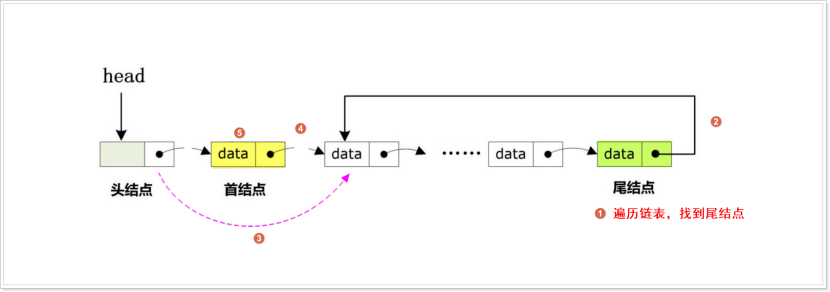/********************************************************************************************************
*
*
* 設計單向迴圈連結串列的介面
*
*
*
* Copyright (c) 2023-2024 cececlmx@126.com All right Reserved
* ******************************************************************************************************/
//指的是單向迴圈連結串列中的結點有效資料型別,使用者可以根據需要進行修改
typedef int DataType_t;
//構造單向迴圈連結串列的結點,連結串列中所有結點的資料型別應該是相同的
typedef struct CircularLinkedList
{
DataType_t data; //結點的資料域
struct LinkedList *next; //結點的指標域
}CircLList_t;
//建立一個空單向迴圈連結串列,空連結串列應該有一個頭結點,對連結串列進行初始化
CircLList_t * CircLList_Create(void)
{
//1.建立一個頭結點並對頭結點申請記憶體
CircLList_t *Head = (CircLList_t *)calloc(1,sizeof(CircLList_t));
if (NULL == Head)
{
perror("Calloc memory for Head is Failed");
exit(-1);
}
//2.對頭結點進行初始化,頭結點是不儲存資料域,指標域指向自身,體現“迴圈”思想
Head->next = Head;
//3.把頭結點的地址返回即可
return Head;
}
//建立新的結點,並對新結點進行初始化(資料域 + 指標域)
CircLList_t * CircLList_NewNode(DataType_t data)
{
//1.建立一個新結點並對新結點申請記憶體
CircLList_t *New = (CircLList_t *)calloc(1,sizeof(CircLList_t));
if (NULL == New)
{
perror("Calloc memory for NewNode is Failed");
return NULL;
}
//2.對新結點的資料域和指標域進行初始化
New->data = data;
New->next = NULL;
return New;
}

//頭插
bool CircLList_HeadInsert(CircLList_t *Head,DataType_t data)
{
}

//尾插
bool CircLList_TailInsert(CircLList_t *Head,DataType_t data)
{
}

//指定位置插入
bool CircLList_DestInsert(CircLList_t *Head,DataType_t destval,DataType_t data)
{
}
//遍歷連結串列
bool CircLList_Print(CircLList_t *Head)
{
//對單向迴圈連結串列的頭結點的地址進行備份
CircLList_t *Phead = Head;
//判斷當前連結串列是否為空,為空則直接退出
if (Head->next == Head)
{
printf("current linkeflist is empty!\n");
return false;
}
//從首結點開始遍歷
while(Phead->next)
{
//把頭結點的直接後繼作為新的頭結點
Phead = Phead->next;
//輸出頭結點的直接後繼的資料域
printf("data = %d\n",Phead->data);
//判斷是否到達尾結點,尾結點的next指標是指向首結點的地址
if (Phead->next == Head->next)
{
break;
}
}
return true;
}

//頭刪
bool LList_HeadDel(LList_t *Head)
{
//對單向迴圈連結串列的頭結點的地址進行備份
CircLList_t *Phead = Head;
}

//尾刪

//指定位置刪除
int main(int argc, char const *argv[])
{
return 0;
}





